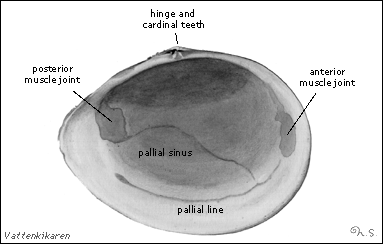|

|
|
The shell
There are several close relations to the
Baltic macoma. This species is recognized by its ligament, which is situated
in the oldest part of the mussel, because it contains only cardinal teeth.
There are no lateral teeth, as is common amongst other species of this
group. The lower delimitation of the mantle bay merges with the mantle
line, and the posterior adductor scar is larger than the anterior. On
the outside of the shell there are weak concentrical lines that go around
the older part of the shell.

Dug down
Contrary to most other specie of mussel,
the Baltic macoma lies on its side and sticks its siphons upwards over
the surface of the sediment. The long and mobile siphons are separate
and can be up to 6 times the legth of the shell. Normally, the Baltic
macoma is found between 3-8 cm deep in the sediment. It can move laterally
by pulling itself through the upper sediment layer, leaving a furrow showing
its movement. During 4 minutes, it can move up to 5 cm.
|
|
Page
1 of 2
|

|
|